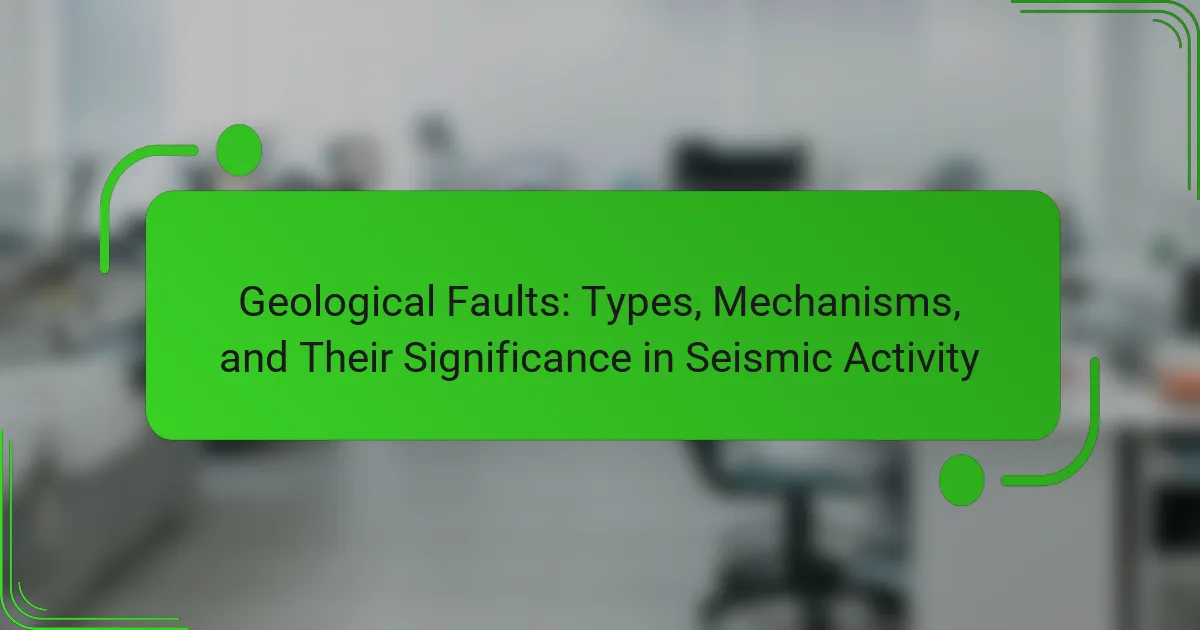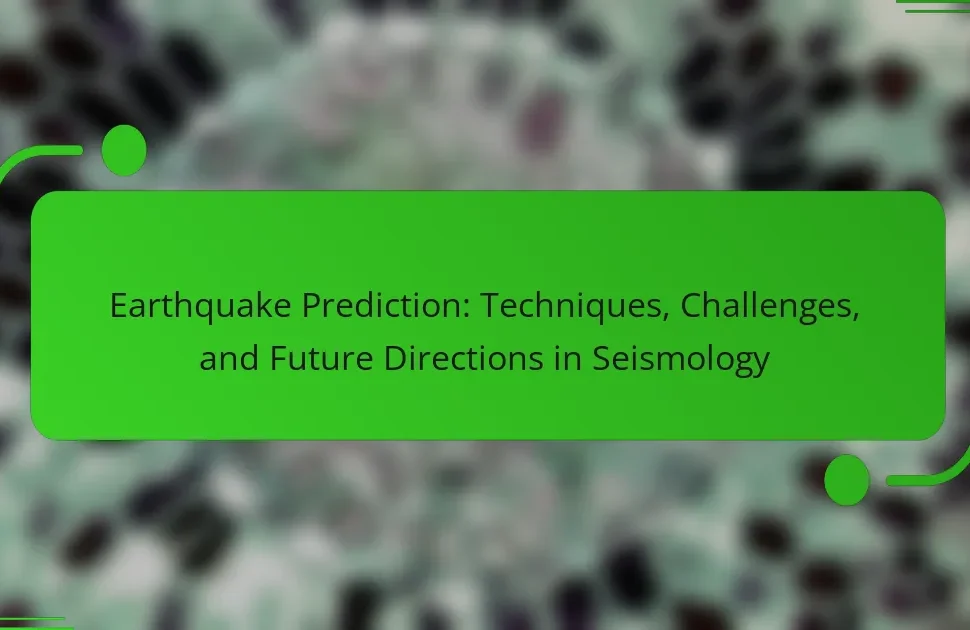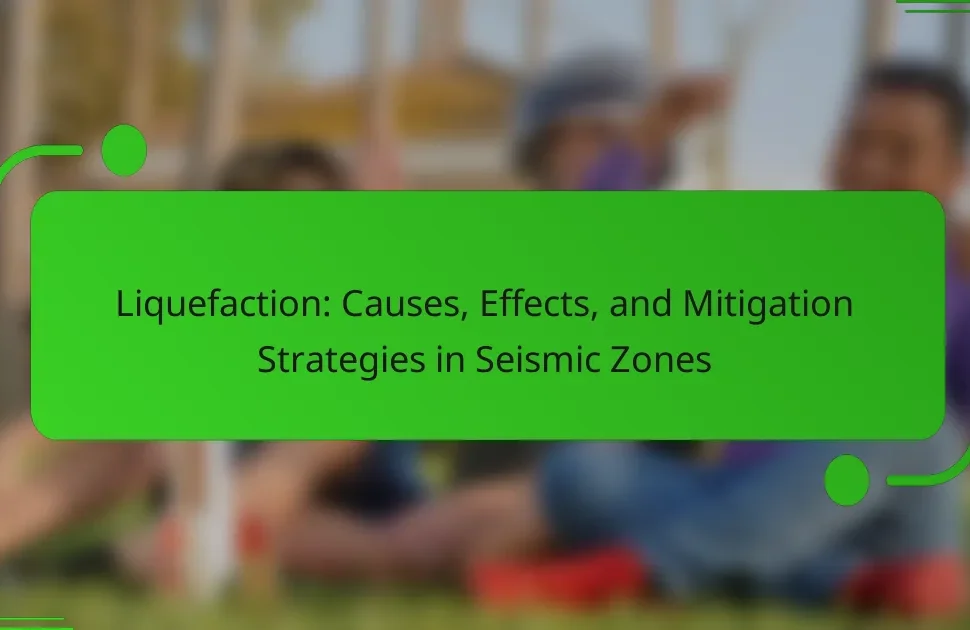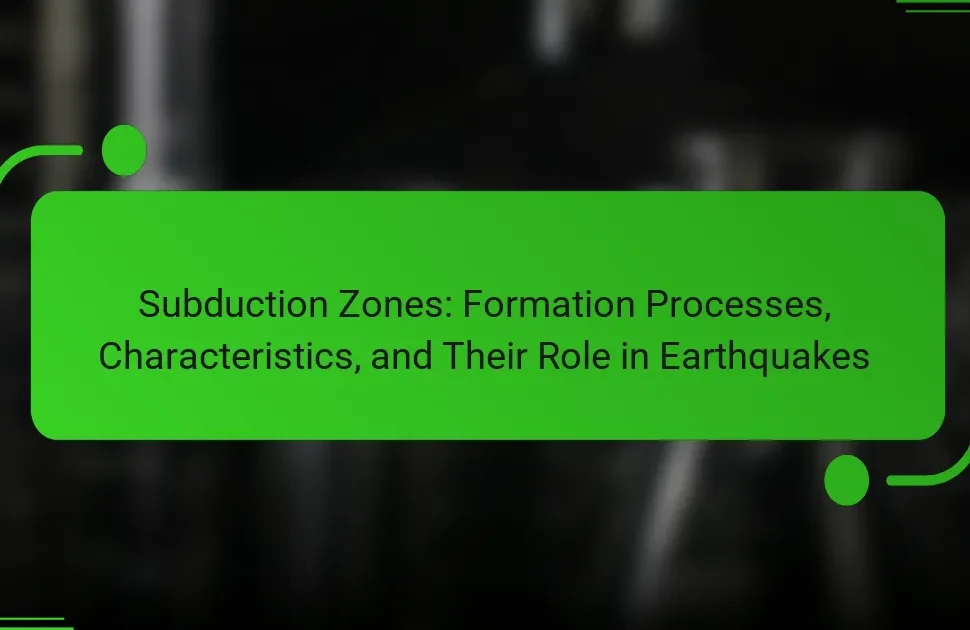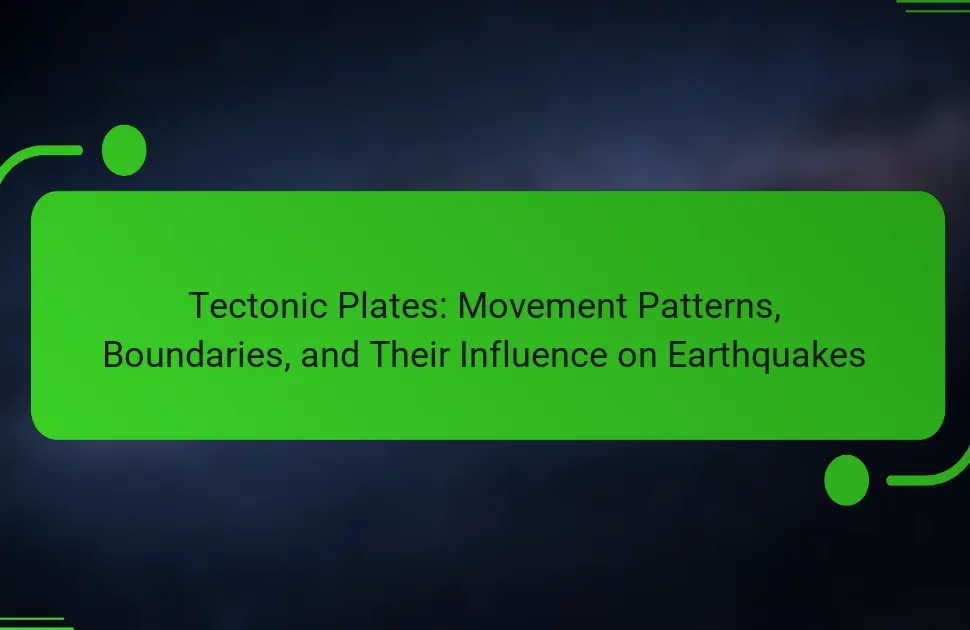Geological faults are fractures in the Earth’s crust where blocks of rock move relative to each other, primarily due to tectonic forces arising from the movement of lithospheric plates. These faults vary in size and are classified into three main types: normal, reverse, and strike-slip. Geological faults are significant in the context of seismic activity, as the stress accumulation along fault lines can lead to earthquakes, which can cause substantial damage to infrastructure and loss of life. Understanding the mechanisms of fault movement and their implications is essential for disaster preparedness and urban planning, particularly in areas prone to seismic events. The article delves into the characteristics of geological faults, their types, and their critical role in shaping seismic risk management strategies.
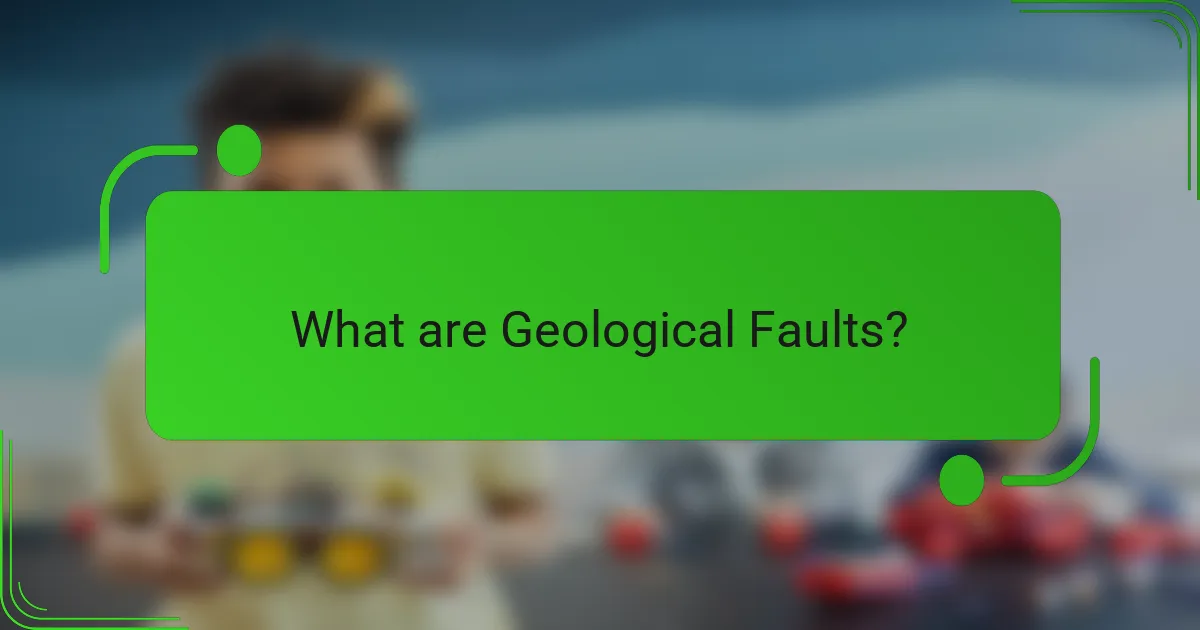
What are Geological Faults?
Geological faults are fractures in the Earth’s crust where blocks of rock have moved relative to each other. These movements can occur due to tectonic forces. Faults can vary in size from a few centimeters to hundreds of kilometers. They are classified into different types, including normal, reverse, and strike-slip faults. Geological faults play a significant role in seismic activity. When stress builds up along a fault line, it can lead to an earthquake. The San Andreas Fault in California is a well-known example of a geological fault. This fault is a strike-slip type and has been the site of numerous significant earthquakes.
How do Geological Faults form?
Geological faults form due to the movement of tectonic plates. These movements create stress in the Earth’s crust. When the stress exceeds the strength of the rocks, they break and slip along a fault line. This process is known as faulting. Faults can form in various ways, including compression, tension, or shear stress. For example, in a compressional environment, rocks are pushed together, leading to reverse faults. In contrast, tensional forces pull rocks apart, resulting in normal faults. Shear stress causes lateral movement, creating strike-slip faults. The formation of faults is a key mechanism in the release of energy during earthquakes.
What geological processes contribute to the formation of faults?
Faults are formed primarily through geological processes such as tectonic plate movement, stress accumulation, and rock deformation. Tectonic plate movement occurs due to the Earth’s internal heat driving convection currents. These movements create stress in the Earth’s crust, which can lead to fractures. As stress builds up over time, it exceeds the strength of rocks, resulting in fault formation. Rock deformation can occur through compression, tension, or shear forces, causing the rocks to break and slip along faults. The San Andreas Fault in California exemplifies this process, where the Pacific and North American plates interact.
How does tectonic activity influence fault development?
Tectonic activity significantly influences fault development by generating stress in the Earth’s crust. This stress arises from the movement of tectonic plates. As plates interact, they can collide, pull apart, or slide past each other. These interactions create zones of weakness in the crust. Over time, accumulated stress exceeds the strength of rocks, resulting in fractures. These fractures are classified as faults. The movement along these faults can lead to earthquakes. Historical data shows that major earthquakes often occur along active fault lines, confirming the link between tectonic activity and fault development.
What are the different types of Geological Faults?
The different types of geological faults include normal faults, reverse faults, strike-slip faults, and oblique-slip faults. Normal faults occur when the crust is extended, causing the hanging wall to move down relative to the footwall. Reverse faults happen when the crust is compressed, leading the hanging wall to move up. Strike-slip faults involve horizontal movement of rocks along the fault line, with little vertical displacement. Oblique-slip faults exhibit both vertical and horizontal movement. Each fault type is characterized by specific stress conditions and movement directions, influencing seismic activity and landscape formation.
What distinguishes normal faults from reverse faults?
Normal faults and reverse faults are distinguished by the direction of movement along the fault plane. In normal faults, the hanging wall moves down relative to the footwall. This occurs due to extensional forces that pull the Earth’s crust apart. Conversely, in reverse faults, the hanging wall moves up relative to the footwall. Reverse faults are caused by compressional forces that push the crust together. The difference in movement direction is a key characteristic that defines these two types of faults. Normal faults typically form in regions experiencing tension, while reverse faults form in areas under compression.
How do strike-slip faults differ from other types of faults?
Strike-slip faults differ from other types of faults primarily by the horizontal movement of tectonic plates. In strike-slip faults, the blocks of the Earth’s crust slide past each other laterally. This contrasts with normal faults, where one block moves down relative to another, and reverse faults, where one block moves up. The primary stress associated with strike-slip faults is shear stress. An example of a strike-slip fault is the San Andreas Fault in California, which showcases this lateral movement. This movement can lead to significant seismic activity, differentiating it from other fault types that may involve vertical displacement.
Why are Geological Faults important in understanding seismic activity?
Geological faults are crucial for understanding seismic activity because they are the primary sources of earthquakes. Faults are fractures in the Earth’s crust where blocks of rock have moved relative to each other. The movement along these faults releases energy, resulting in seismic waves. This energy release is what causes the shaking felt during an earthquake.
Studying geological faults helps scientists predict where earthquakes are likely to occur. Historical data shows that many significant earthquakes have been associated with known faults. For example, the San Andreas Fault in California is well-documented for its seismic activity.
By mapping and analyzing faults, researchers can assess their potential for future earthquakes. This understanding aids in risk assessment and disaster preparedness in vulnerable regions.
How do faults contribute to earthquake generation?
Faults contribute to earthquake generation by storing and releasing stress in the Earth’s crust. When tectonic plates move, they can become locked at fault lines due to friction. This locking causes stress to build up over time. Once the stress exceeds the frictional resistance, the fault slips, releasing energy. This energy release generates seismic waves, which we feel as earthquakes. Historical data shows that major earthquakes often occur along known fault lines. For example, the San Andreas Fault has produced significant earthquakes due to this mechanism. Thus, faults are critical in the process of earthquake generation.
What role do faults play in predicting seismic events?
Faults are crucial in predicting seismic events as they indicate where stress accumulates in the Earth’s crust. When tectonic plates move, they create stress along faults. This stress builds up over time until it exceeds the strength of the rocks. At this point, the rocks break, causing an earthquake. Monitoring fault lines helps scientists assess seismic risk. Historical data shows that regions near active faults experience more frequent seismic activity. For example, the San Andreas Fault has a history of significant earthquakes. Thus, understanding faults aids in forecasting potential seismic events.
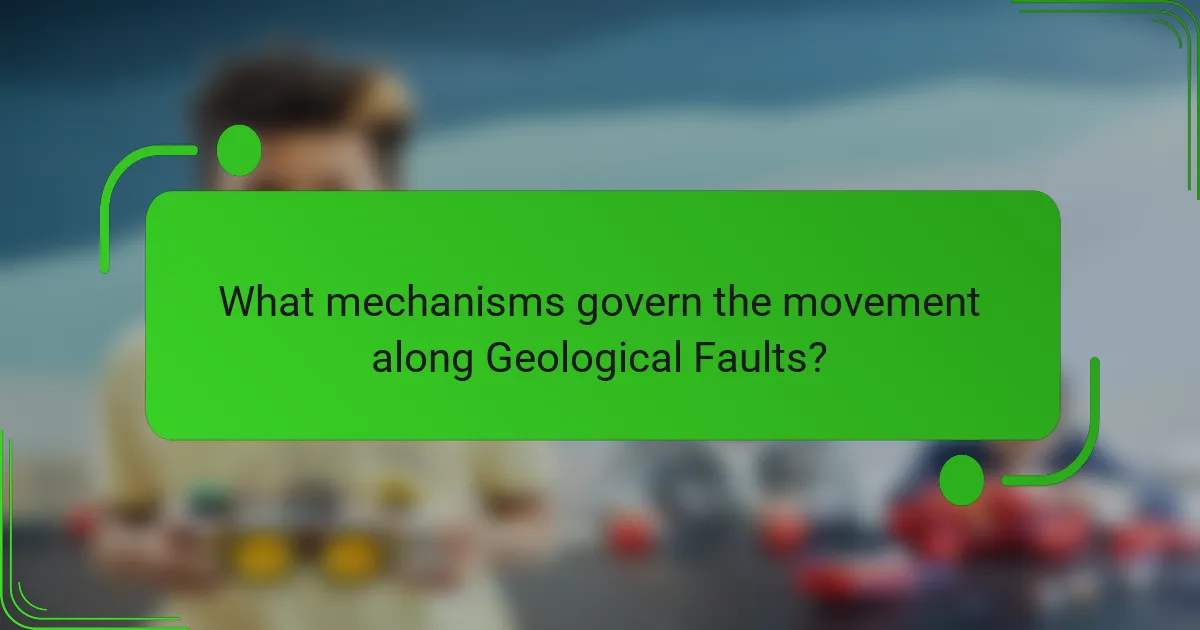
What mechanisms govern the movement along Geological Faults?
Geological faults move primarily due to tectonic forces. These forces arise from the movement of the Earth’s lithospheric plates. Stress builds up in the rocks along fault lines. When the stress exceeds the strength of the rocks, failure occurs, resulting in an earthquake. The movement can be classified into three types: normal, reverse, and strike-slip. Normal faults occur due to extensional forces, while reverse faults result from compressional forces. Strike-slip faults involve lateral movement. The release of accumulated energy during fault movement generates seismic waves. These waves propagate through the Earth, causing ground shaking. The mechanisms governing fault movement are crucial for understanding seismic activity.
How is stress applied to Geological Faults?
Stress is applied to geological faults through tectonic forces acting on the Earth’s crust. These forces can be compressional, tensional, or shear in nature. Compressional stress pushes rocks together, while tensional stress pulls them apart. Shear stress causes rocks to slide past one another. The accumulation of stress leads to strain in the rocks. When the stress exceeds the strength of the rocks, failure occurs, resulting in a fault movement. This movement can release energy, causing earthquakes. Studies show that the interaction of tectonic plates is a primary source of this stress.
What types of stress affect fault movement?
Three main types of stress affect fault movement: compressional stress, tensional stress, and shear stress. Compressional stress occurs when tectonic plates push against each other. This type of stress can cause faults to thrust, leading to uplifted geological features. Tensional stress happens when plates pull apart from each other. This results in normal faults where the crust is extended. Shear stress occurs when plates slide past one another. This can lead to strike-slip faults, where the movement is horizontal. Each type of stress influences how faults behave and can trigger seismic activity.
How does the accumulation of stress lead to fault slip?
The accumulation of stress leads to fault slip by exceeding the frictional resistance along fault lines. As tectonic plates move, they exert stress on surrounding rocks. This stress builds up over time due to the constant movement of the Earth’s crust. When the stress exceeds the strength of the rocks, it causes a sudden release of energy. This release results in fault slip, which is often felt as an earthquake. Research indicates that this process is a key factor in seismic activity. For example, the 2011 Tōhoku earthquake was attributed to the accumulation of stress along the Japan Trench.
What are the characteristics of fault movement?
Fault movement is characterized by the relative displacement of rock masses along a fault line. This movement can occur in various forms, including strike-slip, dip-slip, and oblique-slip. Strike-slip movement involves horizontal displacement, where rocks slide past each other. Dip-slip movement occurs when one block moves vertically relative to another. Oblique-slip movement combines both horizontal and vertical displacement.
Fault movement is also categorized by the rate at which it occurs. This can range from slow, gradual movements to sudden, rapid shifts. The latter often results in earthquakes, which are caused by the release of accumulated stress along the fault. Additionally, fault movement can be influenced by geological factors such as rock type, temperature, and pressure conditions.
Overall, the characteristics of fault movement are essential for understanding seismic activity and the potential hazards associated with it.
What is the difference between elastic and plastic deformation in faults?
Elastic deformation in faults refers to the reversible change in shape or volume when stress is applied. This occurs when the stress is within the material’s elastic limit. The fault returns to its original state once the stress is removed. In contrast, plastic deformation is the permanent change in shape or volume when stress exceeds the material’s yield strength. This results in irreversible changes in the fault structure.
Elastic deformation typically occurs under lower stress conditions, while plastic deformation occurs under higher stress. Research shows that most earthquakes are associated with elastic deformation, which accumulates until it is released suddenly. Plastic deformation can lead to the formation of new fault structures and changes in the geological landscape.
How do earthquakes relate to fault movement characteristics?
Earthquakes are directly related to fault movement characteristics. Faults are fractures in the Earth’s crust where movement occurs. The type of fault movement dictates the nature of the earthquake. For example, normal faults occur due to extensional forces, resulting in vertical displacement. This type of movement can generate earthquakes that are typically less powerful. Strike-slip faults, on the other hand, involve horizontal movement. They can produce significant earthquakes, as seen in the San Andreas Fault. Reverse faults occur under compressive stress, leading to powerful earthquakes. The magnitude and intensity of an earthquake are influenced by the fault type and its movement characteristics. Historical data shows that the largest earthquakes are often associated with reverse and strike-slip faults.
What factors influence the behavior of Geological Faults?
The behavior of geological faults is influenced by several factors. These include stress, strain, and the physical properties of rocks. Stress refers to the force applied to rocks, which can lead to deformation. Strain is the resulting change in shape or volume of the rocks. The type of fault also affects behavior, with normal, reverse, and strike-slip faults behaving differently under stress. Additionally, the presence of fluids can weaken rocks and promote fault movement. Temperature and pressure conditions at depth also play a crucial role. Historical seismic activity provides insights into fault behavior patterns. For example, the San Andreas Fault shows a clear relationship between stress accumulation and earthquake occurrence.
How do geological materials affect fault dynamics?
Geological materials significantly influence fault dynamics. The composition and properties of these materials determine how faults behave during seismic events. For instance, softer materials can lead to more ductile behavior, while harder materials may result in more brittle failure. The presence of fluids in geological materials can also reduce friction along fault lines. This reduction in friction can facilitate slip during an earthquake. Studies show that the type of rock and its porosity affect the stress distribution along faults. Understanding these interactions is crucial for assessing earthquake risk. Research highlights that variations in geological materials can lead to different faulting behaviors in seismic zones.
What environmental factors can alter fault behavior?
Environmental factors that can alter fault behavior include temperature, pressure, and fluid presence. Changes in temperature can affect the physical properties of rocks along a fault. Increased pressure can enhance friction, impacting fault movement. Fluid presence, such as water or gas, can reduce friction and lead to fault slippage. Additionally, seismic activity can be influenced by human activities, such as mining or reservoir-induced seismicity. These factors collectively contribute to variations in fault behavior over time.
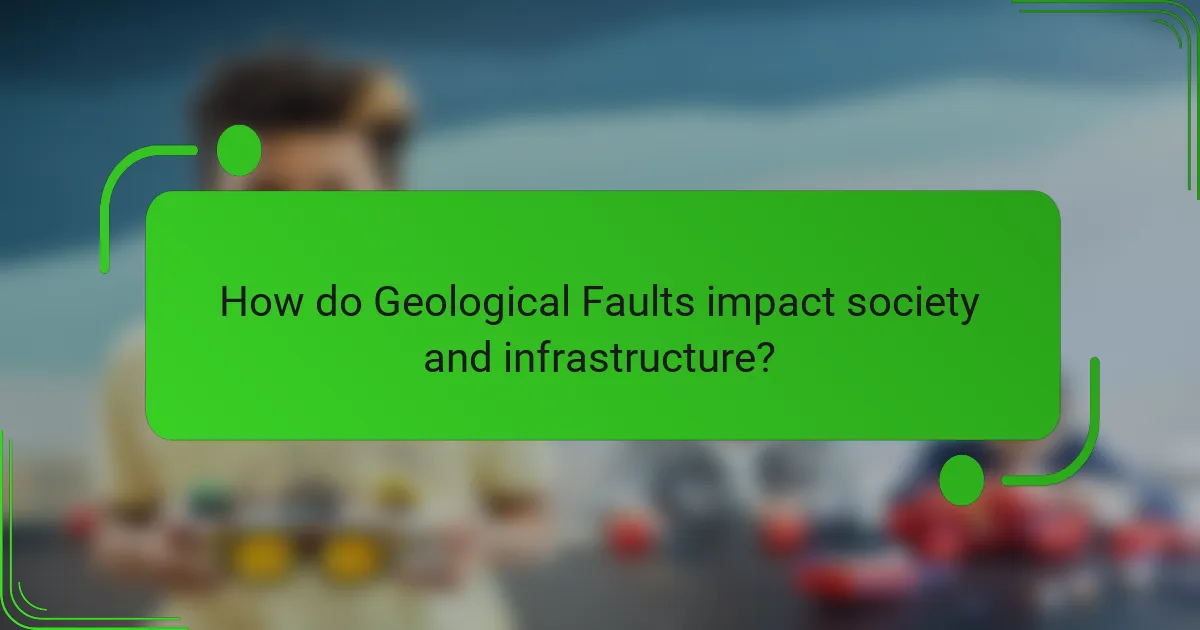
How do Geological Faults impact society and infrastructure?
Geological faults significantly impact society and infrastructure by causing earthquakes. These seismic events can lead to loss of life and property damage. For example, the 1994 Northridge earthquake in California caused over $44 billion in damages. Infrastructure such as roads, bridges, and buildings can suffer severe structural damage during an earthquake. Faults can also disrupt essential services like water, electricity, and communication networks. Urban planning often considers fault lines to mitigate risks. Building codes may require earthquake-resistant designs in fault-prone areas. Understanding geological faults is crucial for disaster preparedness and risk management.
What risks do Geological Faults pose to urban areas?
Geological faults pose significant risks to urban areas primarily through seismic activity. Earthquakes triggered by fault movements can lead to extensive structural damage. Buildings, bridges, and infrastructure may collapse or sustain serious harm. Urban areas often have high population densities, increasing the potential for casualties. Ground shaking can also cause landslides and ground liquefaction, further endangering safety. Historical data shows that cities near active faults experience more frequent and severe earthquakes. For example, the 1906 San Francisco earthquake resulted in widespread destruction and loss of life. Therefore, geological faults represent a critical risk factor for urban environments.
How can faults lead to infrastructure damage during earthquakes?
Faults can lead to infrastructure damage during earthquakes by causing ground shaking and displacement. When tectonic plates move along a fault line, they can release energy. This energy manifests as seismic waves, which shake the ground. The intensity of this shaking can cause buildings and bridges to collapse. Fault displacement can also result in ground ruptures. These ruptures can sever utility lines and damage roadways. Historical events, such as the 1994 Northridge earthquake, demonstrate how faults can cause widespread infrastructure failure. In that event, over 20,000 buildings were damaged, highlighting the risks associated with faults during seismic activity.
What are the implications of fault activity for land use planning?
Fault activity significantly impacts land use planning. It necessitates careful assessment of risks associated with seismic events. Areas near active faults may require stricter building codes. This helps ensure structural integrity during earthquakes. Zoning regulations often restrict development in high-risk areas. Land use planning must incorporate geological surveys. These surveys identify fault lines and their activity levels. Historical data on past seismic events informs planning decisions. Effective land use planning can mitigate potential damage from earthquakes.
What measures can be taken to mitigate risks associated with Geological Faults?
To mitigate risks associated with geological faults, implementing strict building codes is essential. These codes ensure structures can withstand seismic activity. Conducting regular geological assessments helps identify fault lines and assess risk levels. Land-use planning should avoid construction in high-risk areas. Public education on earthquake preparedness is crucial for community resilience. Installing early warning systems can provide alerts before seismic events occur. Retrofitting existing buildings enhances their ability to withstand earthquakes. Monitoring fault movement with advanced technology aids in predicting potential shifts. These measures collectively reduce the impact of geological faults on communities.
How can engineering practices reduce the impact of fault-related seismic events?
Engineering practices can significantly reduce the impact of fault-related seismic events through various methods. These methods include seismic design principles, which ensure structures can withstand earthquakes. For instance, building codes often require flexible materials that absorb shock. Retrofitting older buildings enhances their resilience to seismic forces. Advanced technologies such as base isolators allow structures to move independently of ground motion. Engineers also conduct site assessments to identify vulnerable areas. Monitoring systems can provide early warnings of seismic activity. These practices collectively minimize damage and enhance safety during earthquakes. Historical data shows that regions employing stringent engineering standards experience fewer casualties and less structural failure during seismic events.
What role does public awareness play in fault risk management?
Public awareness is crucial in fault risk management. It enhances community preparedness for seismic events. Informed citizens are more likely to engage in safety practices. Awareness campaigns can effectively disseminate information about local fault lines. Studies show that educated populations respond better during emergencies. For example, the 2011 Japan earthquake highlighted the importance of public drills. Communities with prior training exhibited lower casualty rates. Thus, public awareness directly influences the effectiveness of risk management strategies.
What are the best practices for studying Geological Faults?
The best practices for studying geological faults include detailed field mapping, geophysical surveys, and laboratory analysis. Field mapping allows researchers to observe fault characteristics and surface expressions. Geophysical surveys, like seismic reflection and ground-penetrating radar, help visualize subsurface structures. Laboratory analysis of rock samples provides insights into material properties and fault mechanics. Utilizing remote sensing technologies enhances data collection over large areas. Collaboration with interdisciplinary teams enriches the research perspective. Continuous monitoring of active faults through GPS and seismographs improves understanding of fault behavior. These practices are essential for assessing seismic hazards and informing land-use planning.
How can technology enhance our understanding of fault systems?
Technology enhances our understanding of fault systems through advanced imaging and monitoring techniques. Tools like seismic sensors provide real-time data on fault movements. Satellite radar interferometry allows scientists to detect ground deformation with high precision. Geographic Information Systems (GIS) help visualize fault maps and analyze spatial relationships. Machine learning algorithms can identify patterns in seismic data that may indicate fault behavior. These technologies contribute to improved hazard assessment and risk mitigation strategies. For instance, the United States Geological Survey employs these methods to monitor active faults. Enhanced understanding leads to better preparedness for seismic events.
What methodologies are effective for monitoring fault activity?
Seismic monitoring, GPS measurements, and remote sensing are effective methodologies for monitoring fault activity. Seismic monitoring involves the use of seismographs to detect and record earthquakes. This method provides real-time data on fault movements and can identify patterns of seismic activity. GPS measurements track ground deformation along fault lines. This technique allows for precise measurements of shifts in the Earth’s crust over time. Remote sensing employs satellite imagery to analyze land surface changes. It can reveal long-term trends in fault activity that may not be detectable through other means. Collectively, these methodologies enhance understanding of fault behavior and potential seismic hazards.
Geological faults are fractures in the Earth’s crust where blocks of rock have moved relative to each other, significantly influencing seismic activity. This article examines the formation, types, and mechanisms of geological faults, including normal, reverse, and strike-slip faults. It highlights the role of tectonic forces in fault development and how stress accumulation leads to earthquakes. Additionally, the article discusses the implications of geological faults for society, infrastructure, and urban planning, emphasizing the importance of understanding fault dynamics for risk management and disaster preparedness.
